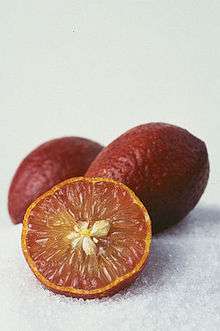Blood lime
Blood limes (or 'African Blood Lime') are a hybrid citrus fruit developed by the CSIRO project to investigate salt-resistant crops.[1]
| Blood lime | |
|---|---|
 Blood limes | |
| Hybrid parentage | Citrus australasica var. sanguinea x 'Ellendale Mandarin' hybrid |
| Origin | Australia |
While the limes proved suitable for high-salt conditions, they have seen no commercial development; the first commercial crop appeared in markets in Australia in July 2004, and are under consideration for export.[2]
The blood lime is smaller than most limes, approximately 4 cm long by 2 cm diameter, and somewhat more sweet than the standard. It is egg-shaped in the winter.[3] The flesh inside a blood lime is composed of red-orange vesicles.[4] The skin can be eaten with the fruit, it is mostly red or burgundy,[2] but can sometimes be green like the standard lime.
The blood lime is a cross between the red finger lime (Citrus australasica var. sanguinea) and the 'Ellendale Mandarin' hybrid.[5] The Ellendale is a sweet orange/mandarin cross.[6] The medium sized trees which have thorns, may be planted as an ornamental,[2] but are only available at some nurseries across Australia.[4]
References
- Powell, Robyn (31 May 2011). "In season". The Sydney Morning Herald. Retrieved 9 December 2014.
- "Jamberoo Valley Farm Australian Blood Limes". jamberoovalleyfarm.com.au. Archived from the original on 18 January 2017. Retrieved 16 January 2017.
- "Blood Lime Red Centre Native Lime - Citrus Gem". theplantshop.com.au. Archived from the original on 18 January 2017. Retrieved 16 January 2017.
- Smith, Camille (1 August 2018). "Blood limes thrive in sandy loam soil on the Bellarine". The Weekly Times. Retrieved 3 August 2018.
- "AUSTRALIAN BLOOD LIME". scienceimage.csiro.au. Retrieved 16 January 2017.
- "Australian Blood lime". Retrieved 16 May 2012.